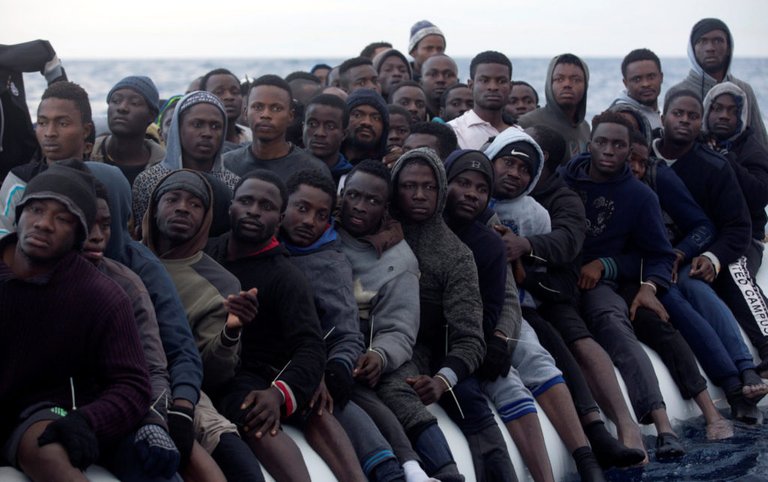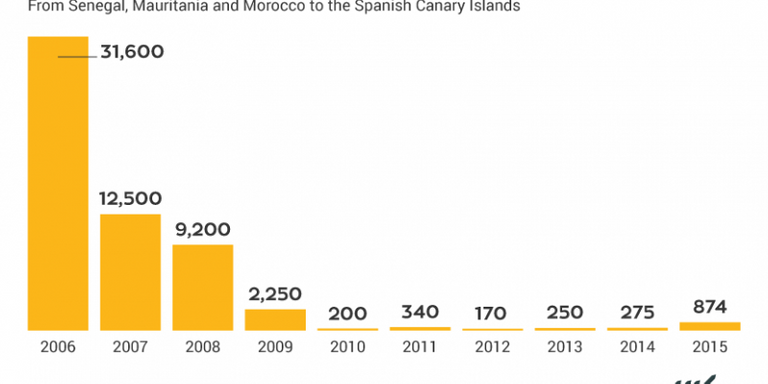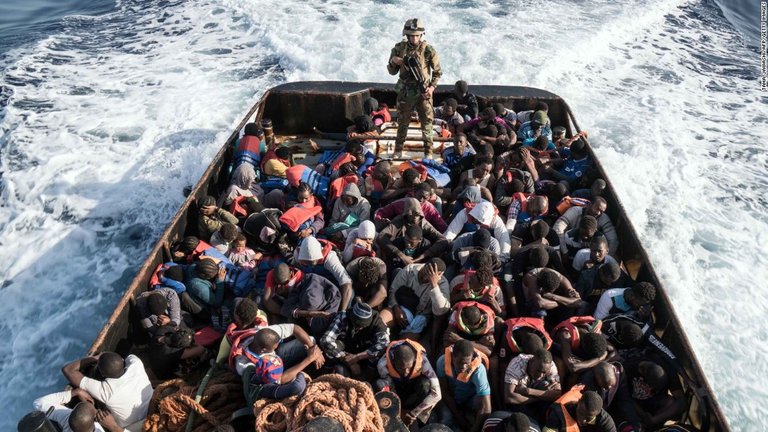SPAIN MIGRANT CRISIS

Source
Migration is not new to us. Globally, one in every 122 human beings is now either a refugee, internally displaced or seeking asylum. According to Filippo Grandi “Migration is not a new phenomenon. History demonstrates that migration has existed for centuries as trade relations, the expansion of empires, wars, persecution and political turmoil have triggered human movement within regions, countries and beyond. Migration is a global phenomenon that pertains to a broader scope of the population than what the media typically refer to as migrants[1]”. Migration is indeed not a new phenomenon it existed in ancient times where the people migrates for them to survive. Even in prehistoric period, migration existed because of their search for foods for survival.
To fully understand everything we must first define what is migration, migration in simple context means to move from one place to another. There are many different forms of migration some migrants migrates specifically for work, others are joining their family members or they enter as asylum-seekers. We can differentiate migration to two, managed and unmanaged, voluntary or forced. Managed migration refers to relocation to a host country in a planned manner such as through quotas or visas. Unmanaged migration refers to migration that the host country has not planned or accounted for. Voluntary migration means relocation according to personal desires. Forced migration is driven by push factors, namely, risks, social pressures and conflicts. In understanding migration we must know its pull and push factors.
Push factors

Source
Push factors include the numerous reasons why migrants might be incentivised to leave their homes. Factor such as humanitarian concerns (including conflicts), overpopulation and destruction of the local environment, wage stagnation, or job scarcity .According to the UNHCR’s annual Global Trends Report: World at War , in the past five years, at least 15 conflicts have re-erupted or re-ignited (eight in Africa: Côte d’Ivoire, Central African Republic, Libya, Mali, north-eastern Nigeria, Democratic Republic of Congo, South Sudan and this year in Burundi); three in the Middle East (Syria, Iraq, and Yemen); one in Europe (Ukraine) and three in Asia (Kyrgyzstan, and in several areas of Myanmar and Pakistan).[2] Since early 2011, the main reason for the acceleration is the war in Syria which is now the single largest driver of displacement. Over the past five years, the Syrian people’s diaspora has led the world to witness the greatest exodus since the end of the Second World War in 1945. UNHCR estimated that in 2015 the figures for forced displacement around the world exceeded 60 million people.Out of the 59.5 million people forcibly displaced in the world by the end of 2014 (8 million more than the year before), 19.5 million were registered as refugees, 38.2 million remained within the borders of their country of origin, and 1.8 million were awaiting a solution to their request for international protection.
Pull factors

Source
Pull factors are incentives for migrants to journey to a certain place and include working opportunities, benefits, ease of travel, the possibility of permanent settlement and the opportunity to reconnect with family and community networks. Pull factors are often created inadvertently by governments. However we must not forget that war isn’t the only reason behind migration. Other drivers such as political instability or violence in the home country, high unemployment rate and poverty within their country, famine triggered by climate change, and systematic discrimination are all motivators for people to migrate.
Last 2015 Europe faced a problem on migrants,according to the International Organisation for Migration (IOM) In Europe alone, more than 1,011,700 migrants arrived by sea in 2015 and, almost 34,900 arrived by land. Upon reflection, we can view 2015 as the year of the migrant crisis in Europe. Especially in Spain, like other countries in Southern Europe, Spain became a destination for immigration in the 1980s for the first time in its recent history. Among other reasons, this transformation was caused by the country’s rapid economic growth over the past two decades, the growing demand for unskilled labor. By 2010 the number of immigrants has increased exponentially and Spain is now the European Union country with the second highest number of foreign residents. 5.7 million foreigners were resident in Spain, representing 12.2% of the country‟s total population. Arrivals of immigrants in Spain began in 2001 and continued through to 2008 up to 2015. “Migrant crisis: Spain rescues 600 people in busiest day,” wrote the BBC. “Spain rescues HUNDREDS of migrants crossing from Morocco,” exclaimed the UK’s Express. According to these reports, there is a growing migrant crisis in Spain as the number of people crossing the Strait of Gibraltar by boat increases. The number of people seeking to reach Spain irregularly is consistently increasing. According to the UNHCR, 3,237 arrivals were recorded by sea in 2013 but by 2016 this had more than doubled to 8,162. In 2017, this process has accelerated and by mid-August there were 9,738 people recorded having made the sea journey. This was more than in all of the previous year.
Where they are travelling from?

Source
As far as the report is concerned those migrants mostly came from the central Mediterranean route, which covers the stretch of sea between North Africa and Italy, specifically from Morocco. There are also some refugees that came from Syria, from its post-colony, Latin America and its neighbor Romania.
Why did they migrate to Spain?
Spain is traditional host country for migrants specifically from Latin-American countries. Spain has traditionally received migration from Latin-America and these historical relations and culture similitudes explains everything.
A second basic feature of this migration pattern is that it is clearly economic migration, since 76% of the new citizens come from countries with a significantly lower per capita income than that of Spain. A higher unemployment increases emigration from home country. Best example is Romania where they suffer economic poverty. One of the most spectacular immigration streams the Romanian population but it is also the nationality with the largest number of residents the highest number of workers with a job contract and the most widespread nationality across the whole of Spain. According to some authors, the country’s strong economic growth between 1998 and 2007, the large demand for labour in a range of sectors, the extensive hidden economy, the rapidly ageing Spanish population, the incorporation of women into the workforce and generous immigration policies that contrast with the restrictive measures adopted by traditional destination countries are the factors for that attracted millions of migrants in Spain. The Spanish government’s migration policy is also a factor in which it encouraged the arrival of Eastern Europeans We must also include the geographic feature of Spain, it is clear that Spain is geographically open to any foreign boats because of their coastlines.
Solution

Source
The UN 1951 Refugee Convention (the ‘Convention’) and its subsequent 1967 Protocol (‘the Protocol’) are the most important legal documents setting out government responsibilities towards refugees globally.
As well as the Convention and Protocol, there are other important instruments (such as the Dublin Regulation in the EU and the European Human Rights Convention) outlining government responsibilities. However many of these instruments are specific to certain countries and regions rather than global in nature. Nearly 150 countries worldwide are signatories to the Convention and the Protocol, although fewer have fully implemented them into law. These documents set out the definition of refugees (or asylum seekers) and a requirement that governments do not return refugees to a territory where his or her life or freedom is threatened (the principle of non-refoulement). They also establish cooperation procedures with the UNHCR.[3]Through this convention signed by them, they promised to receive around 16 thousand refugees from Africa.
And finally, Spanish migration policy, which encouraged the arrival of Eastern Europeans and North Africans while at the same time restricting entry to other groups.While the term “crisis” has been used frequently in international outlets, but it has appeared less in the Spanish media. The Spanish government has refrained from making contentious, headline-grabbing comments or statements. For them it’s too early to speak of crisis.
Bibliography
Bernat, Joan Serafi. Viruela, Rafael. THE ECONOMIC CRISIS AND IMMIGRATION: ROMANIAN CITIZENS IN THE CERAMIC TILE DISTRICT OF CASTELLÓ (SPAIN), 2011, from proquest.com
Elizabeth, Ana. Hernandez, Jardon. International Migration and Crisis Transition Toward a New Migratory Phase, SpringerBriefs in Environment, Security, Development and Peace, 2017.
Grandi Filippo. Managing the refugee and migrant crisis The role of governments, private sector and technology High Commissioner for Refugees, February 2016.
Igonin, Denis. MIGRATION CRISIS IN EUROPEAN POLITICS: THE ETHNIC DISCOURSE, Volume 20, Special Issue 2, 2016.from Proquest.com
Koehler, Jobst., Laczko, Frank., Aghazarm, Christine., Schad, Julia. Migration and the Economic Crisis in the European Union: Implications for policy, International Organization for Migration, 2010.
Mihi-Ramírez, Antonio. The New Migration Flow. An Analysis of Economic Factors of Poland and Spain, 2013 from Proquest.com
[1] Grandi Filippo. Managing the refugee and migrant crisis The role of governments, private sector and technology High Commissioner for Refugees, February 2016.
[2] http://www.unhcr.org/558193896.html
[3]Grandi Filippo. Managing the refugee and migrant crisis The role of governments, private sector and technology High Commissioner for Refugees, February 2016.
Posted from my blog with SteemPress : http://zam398.vornix.blog/2018/10/21/historical-essay-spain-migrant-crisis/
Congratulations @zam398! You have completed the following achievement on the Steem blockchain and have been rewarded with new badge(s) :
Click here to view your Board of Honor
If you no longer want to receive notifications, reply to this comment with the word
STOPDo not miss the last post from @steemitboard: